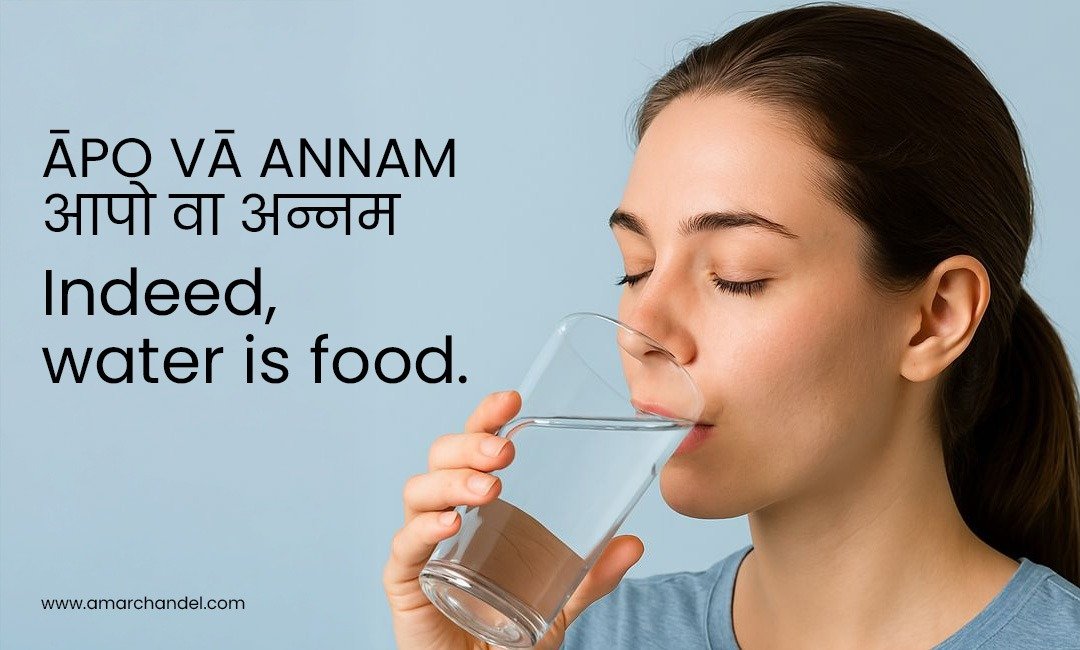Āpo vā annam
आपो वा अन्नम
“Indeed, water is food.”
Chandogya Upanishad (6.26.1)
This is a deceptively simple yet profoundly layered aphorism. It encapsulates an entire worldview in just four words: “Water indeed is food.”
Sanskrit Breakdown and Literal Meaning
• आपः (Āpaḥ) = Water
• वा (vā) = Indeed / verily / truly
• अन्नम् (Annam) = Food/nourishment / that which is eaten and sustains life
Translation: “Āpo vā annam” – “Verily, water is food.”
This is not poetic exaggeration, but a profound Vedantic assertion that shifts the way we view food, life, and the elements.
Spiritual & Philosophical Meaning
- Five Elements and Sustenance
In the Vedantic cosmology, all matter is formed from the five elements (Pancha Mahābhūtas):
• Ākāsh (ether)
• Vāyu (air)
• Agni (fire)
• Āpas (water)
• Prithvī (earth)
Among these, Water (Āpas) is the essential carrier of life-force (prāṇa). This verse proclaims that true food is not solid matter alone (earth element), but that which carries nourishment—and that is water.
- Water as the Essence of Annam
The Upanishadic rishis observed that:
• Without water, food cannot be grown.
• Without water, food cannot be digested.
• Without water, nutrients cannot be absorbed.
Thus, all food is water in essence.
This is why water is not considered separate from food, but the primal food, the basis of sustenance.
- Symbol of Divine Nourishment
Water is not inert in the Upanishadic worldview—it is sacred, intelligent, and a carrier of Soma, the divine rasa. Drinking water with mindfulness is seen as receiving Brahman in a nourishing form.

Contemporary Scientific Relevance
Modern science powerfully validates this ancient insight on multiple levels:
- Human Body is Mostly Water
• 60–70% of the human body is made of water.
• The brain is ~75% water, blood ~83%, and muscles ~75%.
So when we eat food, what we’re really replenishing is water content in structured forms.
- Food Grows Only Through Water
• Crops need precise hydration for nutrient uptake via osmosis.
• Drought or water stress leads to nutrient deficiency in food.
Thus, no food without water—just as the Upaniṣad declares.
- Digestion and Assimilation
• Saliva (99% water) begins digestion.
• Digestive enzymes work only in aqueous environments.
• Water is vital for nutrient transport via blood and lymph.
Without water, food is indigestible and unusable.

- Water as a Medium of Nutrient Delivery
Modern medicine recognises that:
• Vitamins like B-complex and C are water-soluble.
• Nutrients are absorbed into the bloodstream only in solution.
• Intravenous (IV) therapy for malnourishment is primarily fluids first, not solids.
This aligns directly with the idea that “Water is food.”
- Structured Water and Cellular Function
New frontiers in science show that “structured water” inside cells plays a crucial role in:
• Protein folding
• Enzyme activation
• DNA functioning
So even at a cellular level, life functions because of water, not just food.
Health and Lifestyle Implications
• Drinking adequate clean water is not just a hydration strategy; it’s a nourishment protocol.
• Ayurveda recommends sipping warm water before and after meals to aid digestion and absorb the “annam” properly.
• Fasting regimens often allow only water, because the body continues to be nourished by its flow and cleansing.
In modern times of:
• Processed food and poor digestion
• Dehydration due to caffeine, alcohol, and sedentary lifestyles
• Water pollution and scarcity
This Vedic wisdom reminds us:
“If you neglect water, you neglect food. If you neglect food, you neglect life.”
The rishis of yore did not need microscopes to know what life needed. In saying “Āpo vā annam”, they declared that:
• Water is not merely an accessory to food—it is food.
• Water is nourishment, life-force, Soma, and Prāṇa.
• It is the unseen carrier of vitality, the fluid Brahman flowing through all life.
So,
• Begin meals with gratitude for water: “आपो वा अन्नम्” can be a mantra of mindful drinking.
• Prioritise hydration as nutrition, not just thirst-quenching.
• See water as sacred, not just a commodity.


Give a Reply